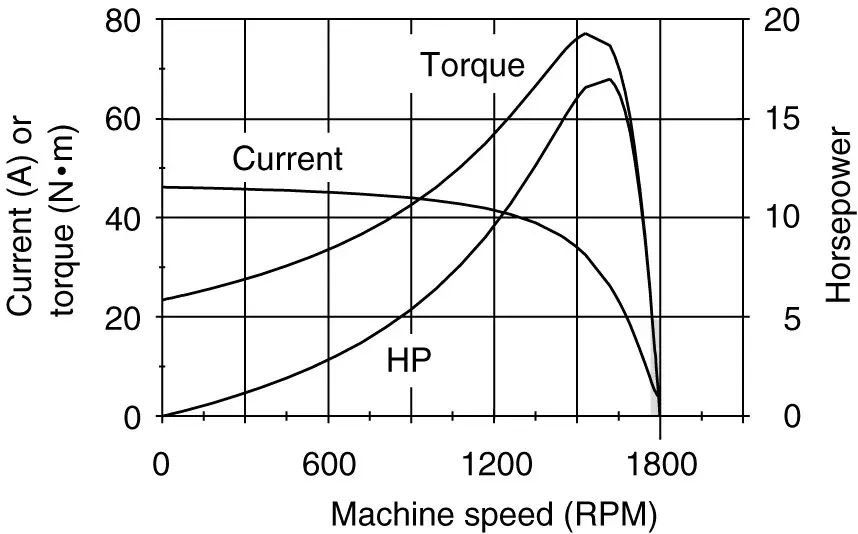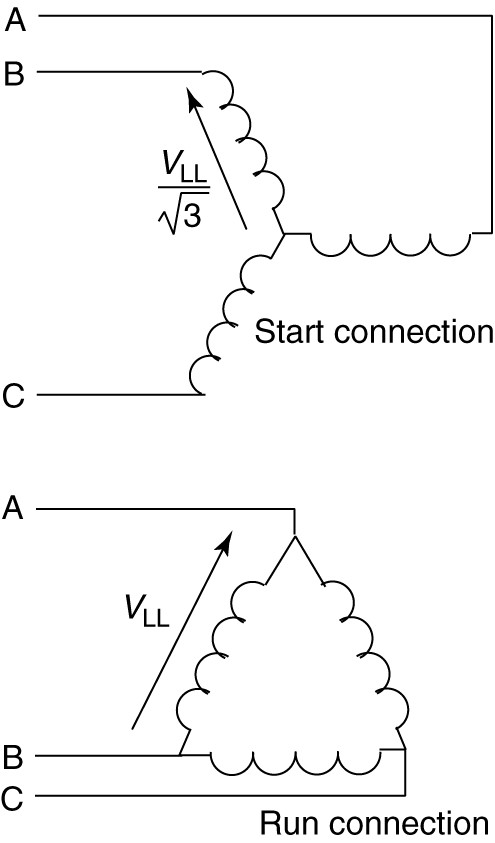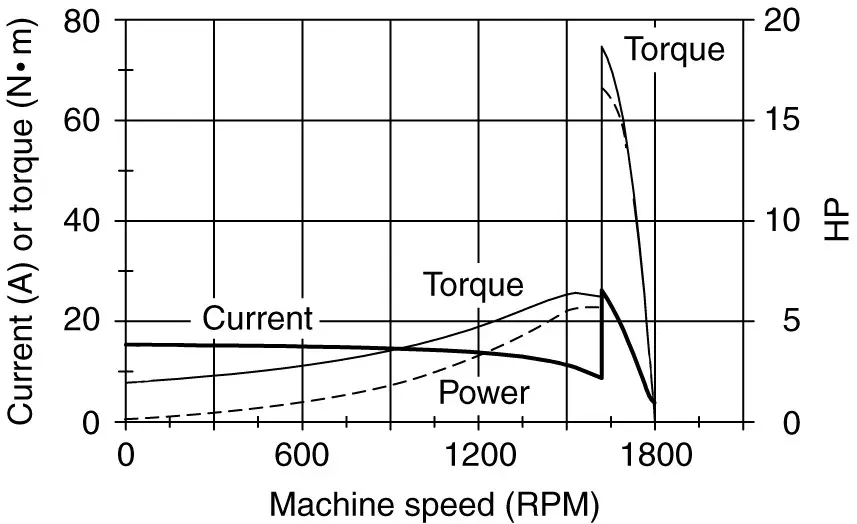Three-phase Induction motors draw six or more times rated current when started at rated voltage. Such high currents may pose serious problems for the motor and the electrical system when large motors are started. One way to reduce the starting current is to start the motor at reduced voltage. After looking at some of the considerations for full-voltage starting, we will consider several different methods of reduced-voltage starting.
Full-voltage starting of Induction Motor
Full-voltage starting means the line voltage is applied directly to the terminals of the three-phase induction motor. The advantage of full-voltage starting is that the full locked-rotor torque is obtained, which may be required for hard-to-start loads. The disadvantage, of course, is the high starting current.
FIGURE 1 Induction motor characteristic curves.
As shown in Figure 1, the current stays near its locked-rotor value until the motor accelerates beyond break-down torque. Because locked-rotor current is approximately six times rated current and heating is proportionate to I2, we can conclude that copper losses will be about 36 times normal during the motor-starting period. The induction motor cannot withstand such a high rate of heating for very long. In particular, slow acceleration of the motor due to heavy loads, or repeated starts, may overheat the induction motor. To preclude thermal damage to the induction motor, manufacturers recommend that locked-rotor current is allowed to last only for a brief time (10-15 s). One manufacturer’s recommendations are:
10 s for frame sizes 143T through 286T
12 s for frame sizes 324T through 326T
15 s for frame sizes 364T through 445T
Continuous-rated motors are typically rated for:
- Two successive starts with a full stop in between, when the motor is initially at ambient temperature, or
- One start when the motor temperature is between ambient and rated operating temperature
Reduced-voltage starting of Induction Motor
In some cases, especially for larger three-phase induction motors, it is necessary to start the motor at less than rated voltage to limit the current to (and the heating of) the motor. As we see in equation 1, reducing the voltage reduces the shaft torque by the square of the voltage reduction. Thus, starting the motor at reduced voltage means the motor produces less torque and a long time will be required to accelerate the motor to its normal operating speed.
\[\begin{matrix} {{T}_{d}}=3\frac{{{R}_{r}}}{s{{\omega }_{r}}}\times \frac{{{\left| {{V}_{1a}} \right|}^{2}}}{\sqrt{{{\left( {{R}_{e1}}+\frac{{{R}_{r}}}{s} \right)}^{2}}+{{\left( {{X}_{e1}}+{{X}_{r}} \right)}^{2}}}} & {} & \left( 1 \right) \\\end{matrix}\]
However, because the current is reduced, the heating will also be reduced and a longer acceleration time is permissible. Several methods are available for reduced-voltage starting of induction motors:
- Y start, ∆ run (frequently called wye-delta starter)
- Auto-transformer start
- In-line resistor or inductor
- Electronic “soft starter”
Y-∆ (Delta) Starter
Figure 2 shows the principle of the Y-Delta Starter. The phase coils are designed to be connected in Delta for running, but they are connected in Y to start the motor. Each coil receives times the line voltage during starting, which means the current and torque 1/3 of what they would be during a full voltage start. When the motor nears rated speed, the coils are momentarily opened and reconnected in Delta to receive full line voltage. This type of starting requires a motor designed for Y-Delta starting (6 or 12 leads) as well as control equipment to switch the connections. When Y—Delta starting is used, a maximum of 36 seconds is allowed for the acceleration time if the motor is brought to full speed on Y. If a full voltage is applied during acceleration, the maximum allowable starting time is 15 seconds.
FIGURE 2 Y-D starting of an induction motor.
Figure 3 shows the current, torque, and horsepower for the motor that is started with a Y-Delta starter. When the motor was started on full voltage, the starting current was approximately 47 A. In Figure 3, we see the current has been reduced, as expected, by a factor of 3, down to about 16 A. For purposes of the illustration, this motor was switched to the Delta configuration when the break-down torque was reached.
FIGURE 3 Results of Y-Delta motor start.
- You May Also Read: Torque Speed Characteristics of Induction Motor
Autotransformer Starting
Another technique for starting large induction motors is to reduce the voltage with an autotransformer. A three-phase autotransformer is used to reduce the voltage applied to the motor during the starting period. The taps on the autotransformer can be adjusted offering the choice of several different levels of voltage reduction. This technique has the advantage of working with an induction motor. Like the Y-Delta starter, this method requires controls to do the switching. The disadvantage of the autotransformer starter is that the current level is reduced exactly the same as the voltage, while the torque reduction is still the square of the voltage reduction. In addition, there will some exciting current required for the autotransformer. The allowable starting time for an autotransformer start depends on the voltage reduction. If the motor is brought to full speed on reduced voltage, some manufacturer recommendations are:
80% voltage during starting →19 seconds allowed for acceleration
65% voltage during starting →28 seconds allowed for acceleration
50% voltage during starting → 48 seconds allowed for acceleration
ln-Line resistor or inductor starter
This method places an impedance (resistor or inductor) in series with each phase of the motor. By voltage splitting, the voltage is reduced to the motor. By using different impedances, different voltage reductions can be obtained. Like the autotransformer, this method works on a standard motor and requires controls to switch the impedances in and out. The current reduction is the same as the voltage reduction in this method, and extra energy is dissipated if a resistor starter is used.


